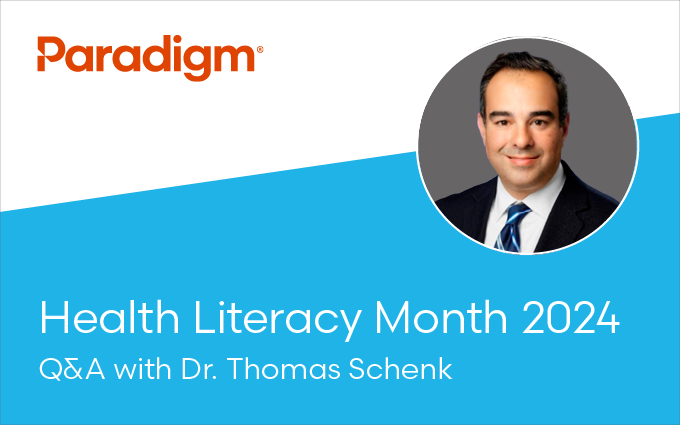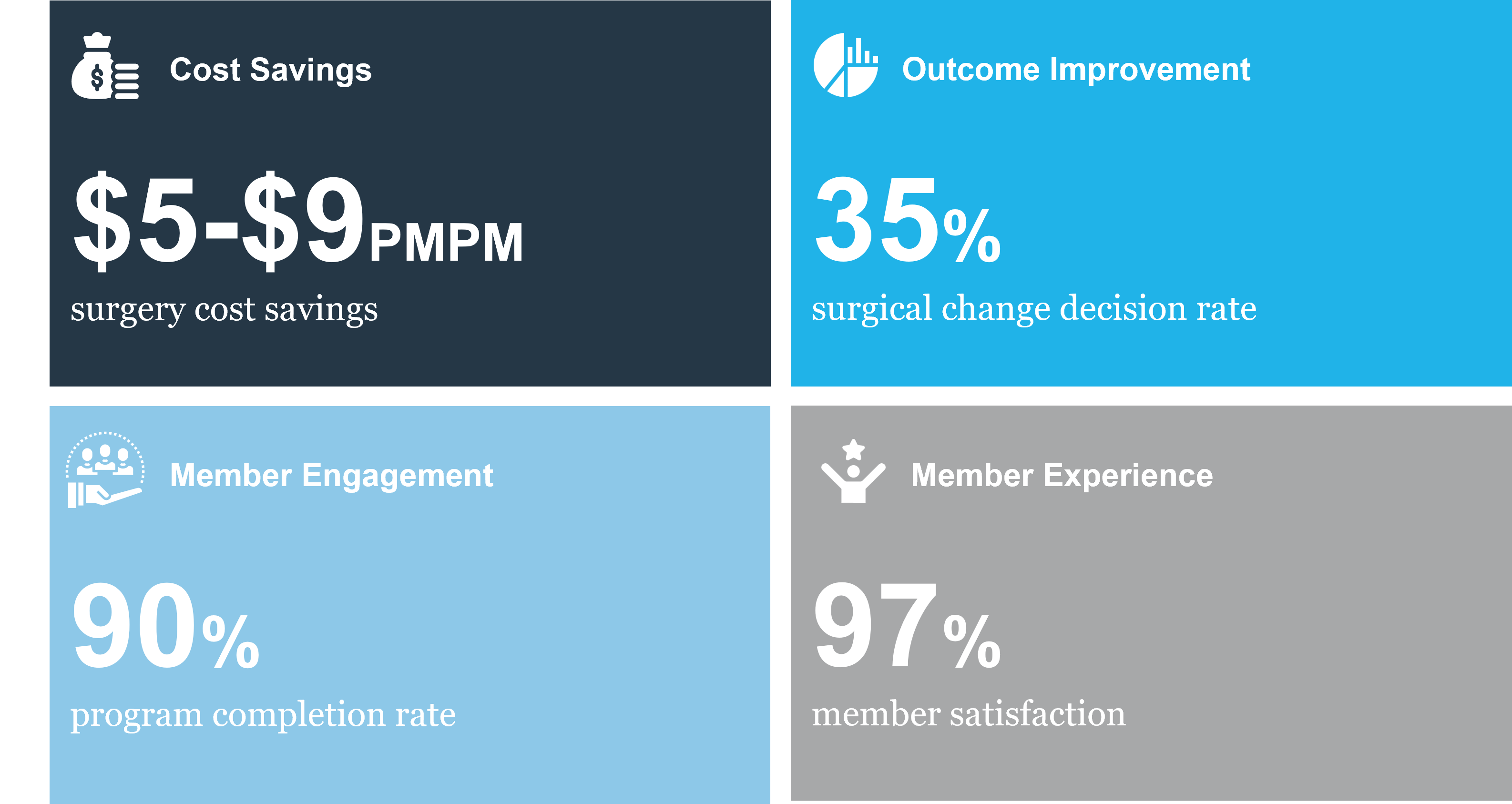10/22/2024

Every October, we celebrate Health Literacy Month—a time to recognize the critical role of health literacy in empowering patients to make more fully informed care decisions. In a world filled with an abundance of health information, knowing how to navigate, understand, and utilize valuable insights for better well-being is vital.
As we close out Health Literacy Month, we sat down with Dr. Thomas Schenk, Paradigm’s Chief Medical Officer, to get some important insights on the role of health literacy in achieving better outcomes for patients.
Q. What is health literacy and why is it important?
A. Health literacy encompasses a person’s ability to access, understand, and effectively use health information to maintain and promote good health. It is a crucial component to a person’s overall well-being, as there is clear data that directly correlates a person’s health literacy level to their health outcomes.
For example, the U.S. Department of Education published a study that found that adults who self-report the worst health also have the most limited overall literacy, numeracy, and health literacy skills.
Q. How does health literacy impact the patient journey and health outcomes?
A. If a patient fully understands the goals related to their care, then they can play an active role in determining the approach to reach those goals. We’ve found that when patients agree with treatment goals and understand the steps in their journey, they are more likely to stay engaged, follow through, and ultimately reach the desired outcome. In such cases, the relationship between patient and provider transforms into a collaborative one, leading to shared decision-making and improved engagement in their care plan.
Q. What are common challenges or barriers to health literacy? How can healthcare providers and patients work together to ensure effective communication and understanding, particularly in cases where the patient’s health literacy may be limited?
A. Health literacy challenges can arise from several factors. Some of these barriers are tied to limited overall literacy, language barriers, and social determinants of health. Others are linked to a lack of trust with healthcare providers, or discomfort in addressing one’s own health issues.
Historically, not all healthcare providers have been focused on assessing and advancing patient health literacy; however, given the importance of health literacy in achieving desired outcomes, we need to engage more. It’s important to build processes into the way people experience care that reinforce and teach health literacy basics. There are simple steps that we providers can take to use our time with patients as a teachable moment: understand patient language preferences, use clear, plain language, and utilize graphics to simplify complex concepts.
Listening to patients and mutually agreeing on a care plan is essential—every interaction should be one of two-way communication. Provide clear written instructions, and double-check the patient’s understanding of the plan and next steps by encouraging them to repeat or summarize. Also, create accessible follow-up channels to provide easy, ongoing support for the patient when they need it.
Q. How does health literacy tie into shared decision-making between healthcare providers and patients? What are the benefits of a well-informed patient in this context?
A. The ability to have a discussion that builds consensus around a plan of care is dependent on the patient having the needed level of health literacy. Patients who understand the plan of care, the next steps, and who have participated in creating that plan are more likely to follow through.
Improved health literacy empowers patients to actively engage in their care, which leads to better health outcomes, fewer complications, reduced healthcare costs, and the avoidance of redundant and emergent care. It’s estimated that improving health literacy could prevent one million hospital visits, while saving over $25 billion a year among the Medicare population alone. From both a cost and consumer standpoint, the benefits are undeniably positive.
Q. What about health education tools? Are they effective in improving health literacy? What elements make them most effective?
A. While there are few health education tools that are used consistently across the industry, the right ones can make a significant impact on health literacy. The most effective tools are based in evidence and teach patients how to engage with their physician to make decisions, together. In fact, patients who have access to evidence-based programs that teach shared decision-making have been shown to make more appropriate and less risky care decisions. By using educational intervention to improve health literacy and reduce demand for inappropriate care, these programs can drive better outcomes and lower costs.
The process of educating patients begins with the ability to engage them. Tools should incorporate simple, yet effective, elements like straightforward language, multilingual capabilities, visual aids to clarify complex ideas and concepts, personalized guidance, and clear takeaway materials that reinforce and support the individual in shared decision-making preparation and articulating their care goals.
These elements are all essential to effectively improve health literacy and they are one reason that Welvie My SurgerySM has been a unique product since its inception. These crucial components that have been shown to support and grow health literacy have been in the My Surgery DNA from day one.
Q. In what treatment areas do health literacy tools have a significant impact, and what does that impact look like?
A. The importance of health literacy is felt across the healthcare continuum, but one of the most significant times is when a patient needs surgery. There are few more important times to be empowered to make the most fully informed care decisions. We see surgery as a pivot point where patients innately become more invested in understanding and engaging in their treatment plans, and they begin to proactively ask questions.
This is why we developed Welvie My Surgery, which is a population-based, evidence-supported shared decision program that reduces patient demand for inappropriate surgery and improves outcomes for necessary procedures using educational intervention. The program has been proven to improve the patient experience around surgical consideration and preparation, while reducing post-surgical complications and deaths. With our approach, better health literacy yields better results for patients and lower costs for health plans.

Q. Can you share some immediate resources for patients who want to enhance their health literacy and better engage in their healthcare?
A. Improving health literacy must be a collaborative effort between patients, providers, health plans, social agencies and more. Thankfully, we are seeing an increase in resources and tools available to all. The Agency for Healthcare Research and Quality (AHRQ) website has several patient-focused activities, from short videos to lists of questions to ask your doctor. It’s a great first stop for people who want to improve their health literacy level.
Thank you to Dr. Schenk for these valuable insights on the profound impact of health literacy. Health literacy is a vital aspect of achieving better health outcomes, fostering patient-provider collaboration, and creating a more efficient and cost-effective healthcare system. It’s a shared responsibility among healthcare providers, health plans, and patients to enhance the well-being of individuals and communities.